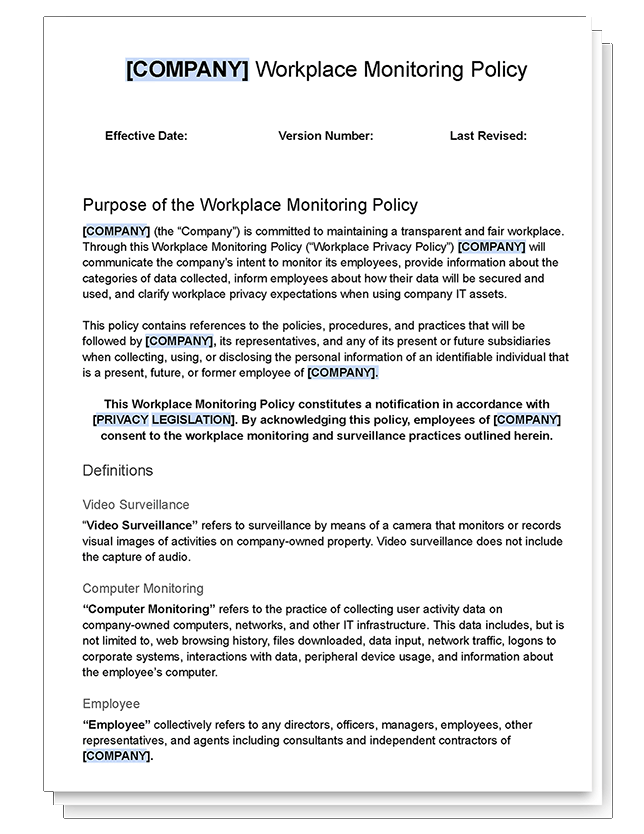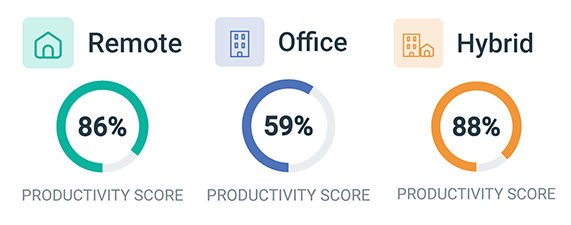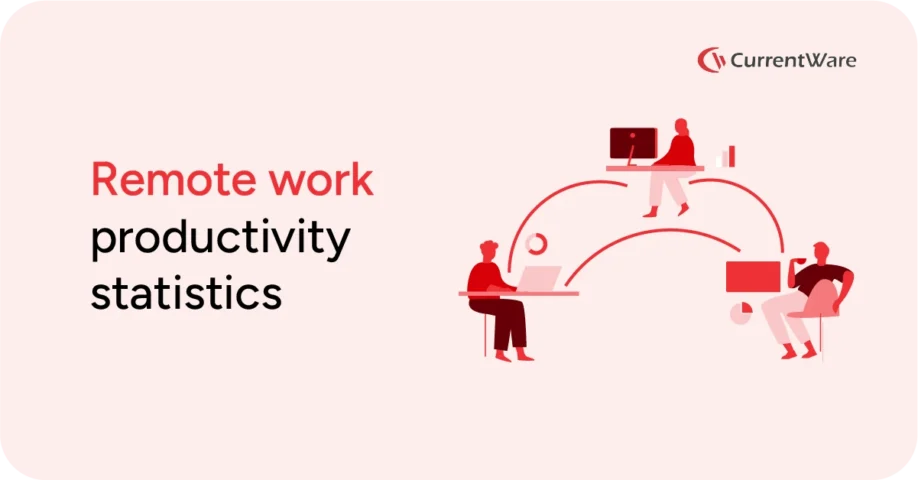10 Work From Home Productivity Tips for Managers

Looking to improve the productivity of employees who work from home? Consider these work from home productivity tips for managers to improve your remote workforce productivity management skills.
Table of Contents- 1) Boost Morale With Virtual Hangouts
- 2) Manage and Track Remote Employee Computer Usage
- 3) Implement Communication Platforms
- 4) Update Calendars Regularly
- 5) Provide Necessary Equipment
- 6) Be Open to Feedback
- 7) Schedule Regular One on Ones
- 8) Create Shared “To Do Lists”
- 9) Trust in Your Employees
- 10) Write a Work From Home Policy
Preamble
When the COVID-19 pandemic flipped the entire world upside down, companies and managers were forced to implement a work from home strategy whether they liked it or not.
Companies quickly pivoted, devising work-from-home policies and procedures in order to create the most effective environment for their workforce to operate from their homes while maintaining productivity.
Over the course of the past year and a half or so, many companies and employees have realized the many benefits that working from home offers. Less time spent in traffic, lower overhead costs that come with an office space, reduced environmental impact, and many more reasons are leading companies to consider long-term work from home programs.
Follow these work from home productivity tips for managers to improve how you manage your remote workforce.
1) Boost Morale With Virtual Hangouts

The physical connection and social atmosphere that an office space provides is difficult, if not impossible, to emulate in a virtual and remote environment.
Whether it be the token water cooler talks, weekly team lunches or drinks after work, the social aspect of a company team is an important element to its longevity and success. All of these unique social connections create stronger bonds between employees, leading to greater collaboration and overall happiness.
Luckily for team leaders, there are many different ways to connect with employees while working from home. Virtual social hangouts can be something as simple as having the team join a video call with cameras on to cheers to a successful work week, or they can even involve one of the widely used online games.
Virtual trivia, bingo and scavenger hunts are all popular activities for your team to enjoy. Reach out to your team to see what days and times would work best, and ask them what type of game they’d want to play most.
2) Manage and Track Remote Employee Computer Usage

Workplace Monitoring Policy Template
- Disclose your company’s intent to monitor employees in the workplace
- Set workplace privacy expectations for employees
- Meet transparency requirements for compliance with privacy laws
Get started today—Download the FREE template and customize it to fit the needs of your organization.
Business owners and managers alike have long been hesitant to allow employees to work from home given the uncertainty surrounding their behaviour and productivity levels. With distractions ranging from television, video games, personal errands and family life, there are definitely many reasons for concerns.
How can managers be certain that their workers are actually working?
Security has also been a concern when employees work from home. WFH employees could fall victim to any number of cyber attacks while browsing, or even use portable storage devices to steal sensitive information.
Fortunately for companies that have adapted a work from home strategy, CurrentWare’s work from home productivity tracker and other security solutions monitor and control the internet and application usage of remote workers. With this technology in place, managers have the ability to keep WFH employees productive and secure.
3) Implement Communication Platforms

Replacing the atmosphere of an in-person brainstorm session may be impossible, but implementing the right virtual communication platforms for your remote team will be one of the foremost important steps you take to successfully manage your team while working from home.
Tools such as Microsoft Teams, Slack, and Zoom are highly popular and effective apps for day-to-day communications and collaboration for work teams of any size. With these tools, employees and managers can instantly chat and video call each other, helping to reduce the levels of disconnect while creating a more productive online work space.
4) Update Calendars Regularly

One of the most challenging obstacles that a remote work team faces is the poor line of sight into each other’s schedules and the inability to spontaneously pop into a meeting room to connect. All of the popular email and chat platforms have built-in calendar applications that allow for employees to manage their daily schedules.
Unfortunately, these calendars can often become swamped with meetings that aren’t intended or necessary for each employee, creating a schedule that appears to be busier than it actually is.
When this happens, availability over the scheduled time of those meetings will appear to be unavailable for colleagues to schedule. This frustrating occurrence can easily be avoided if managers stress the importance of maintaining an updated and accurate schedule on their calendar.
5) Provide Necessary Equipment

For many employees who have had to create a new workspace in their home, the standard equipment of their old office is likely not available. After being accustomed to work equipment and technology such as a second monitor or an ergonomic chair, employees will likely not be as productive or comfortable working from home without those.
Dual monitors are important for employees working from home as they make collaborating much easier as opposed to just a single screen. Sharing a video call on one screen while working on a project on the other is common for virtual collaboration projects and will definitely help to increase overall production and quality of work.
For those working with many different applications, having the dual monitors creates a much less cluttered screen and provides greater efficiencies as they can quickly swap and share work from one screen to the other.
The importance of ergonomics is at the forefront of practically all office equipment design. This is especially true for the office chairs that workers are sitting in for long periods of time. The comfort levels and ergonomic support of a chair will go a long way in creating a healthier and more productive environment for employees to work in.
The more comfortable and the healthier that your team is, the more work they will be able to get done in the long run. Despite the costs that may come with providing quality equipment to a large team, doing so will help improve employee happiness, health and overall productivity.
6) Be Open to Feedback

Regardless of the leadership position that you are in as a manager, providing a space for your employees to give their advice and feedback on your work from home policies and processes will go a long way in creating a more functional remote work environment.
For companies new to the work from home concept, there will certainly be a learning curve and such companies should focus on how the team is responding to the change. Making adjustments to your work from home plan won’t make you seem to be a misguided manager, but will instead show to your team that you are listening to their concerns and needs as you do want them to be happy.
There are many free to use anonymous feedback forms available for managers to have employees share their feedback without the fear of creating animosity or distaste. At the end of the day, the employees are every company’s greatest asset and their feelings and input should be taken into consideration throughout every step of a solid work from home plan.
7) Schedule Regular One on Ones

Making an effort to bring the team together as a group is definitely important in order to maintain a strong positive company culture, but it’s just as important to also connect with your employees regularly at a one on one level.
Creating a time and space for these one on one meetings will provide an opportunity for your employees to openly express how they are feeling with their work responsibilities, professional development, the struggles they may be facing, and anything else that they are open to discussing.
As a manager, this will give you grand insight into the direction that each individual is working towards and will allow you to better understand both the negatives and the positives resulting from the work from home reality.
These meetings should also be used to have your employees share their goals with you so that you can help them with their professional development and help direct them along their career path. With goals clearly planned and shared, your employees will feel motivated as they work towards their future.
8) Create Shared “To Do Lists”

Managing the tasks of each worker is difficult enough, let alone when managing a team of remote workers. Without the ability to check in on each employee like you’d be able to in an office, it is easy to lose track of each task that employees are working on.
Creating a shared to-do list with the team will provide a clear line of sight for each member of the team to see the status of each task. You may also wish to have employees fill out the amount of hours worked on each task to further gauge how long each individual task should take, giving you a better understanding of how to properly delegate work.
9) Trust in Your Employees

WFH employee monitoring software is a valuable tool for understanding the workflows of remote workers, enforcing WFH policies, and preventing time theft. That said, it’s critical that managers of WFH employees avoid becoming overbearing about minor deviations when assessing the productivity of remote workers.
Once you’ve provided the training, resources and tools necessary to create an efficient work from home environment for your team, it will be important as a manager to have faith and trust in your employees.
Spending an excessive amount of time worrying about each individual’s productivity and conduct while working from home will eventually start to affect your own output. Unless your remote workers are clearly off-track or egregious behaviors are found, it is critical to believe in them and trust in the processes you have laid out and the resources which you have provided them.
Giving your employees the room to breathe and work without constant check-ins will also help them to develop their own levels of focus and discipline as they adjust to their home office life. This will instill confidence within them as they will likely take pride in the fact that they have gained your trust to be productive workers without the need for overbearing supervision.
Rather than stepping in each time productivity dips, use the remote employee productivity reports to monitor for actively disengaged employees. Compare their activity reports to their expected outputs to make a data-informed decision about whether or not non-work web browsing is affecting their quality of work
10) Write a Work From Home Policy
A work from home policy is an essential remote workforce management tool. The best work from home policies clearly defines how employees are expected to conduct themselves while they work remotely. Your policy should include references to relevant policies, procedures, and other internal support documents that your remote workers can refer to as they transition to working from home.
A work from home policy will cover:
- Home office requirements
- WFH IT support processes
- Performance expectations
- Communication protocols
- Cybersecurity standards
Learn More: How to Make a Work From Home Policy
Get Your FREE Work From Home Policy Template
- Define eligibility requirements for remote/hybrid work
- Communicate security, productivity, and schedule expectations
- Set acceptable use of company assets for WFH employees
Get started today—Download the FREE template and customize it to fit the needs of your organization.
Conclusion
Though the thought of working from home may seem to be a relatively new concept, up until the Industrial Revolution people were mainly running their businesses out of their homes. Shopkeepers, blacksmiths, carpenters and many others lived in the same houses that they worked out of.
In the late 18th century, during the rise of the first Industrial Revolution, workers began putting down their tools at home and started heading to the cities to pursue work within the large factories, mills or mines that were being established at an extraordinary rate.
For hundreds of years following, working out of a factory or an office space in the city became the norm for billions of workers around the world. The ever expanding landscape of technology brought forth new industries, creating the need for a more diverse workforce. This diverse workforce included engineers, teachers, doctors and politicians, all of which were commuting daily throughout the city to punch in for work.
It wasn’t until the world wide web became more and more mainstream throughout the 1980s and 90s that people began to realize the potential opportunity to work from home. With a personal computer and an internet connection, employees across many different industries were able to login and get their work done from home.
Despite its indisputable potential, most companies were hesitant to fully adopt a work from home strategy due to concerns around productivity and security.
By following these work from home productivity tips for managers you will be one step closer to creating a productive remote workforce.



